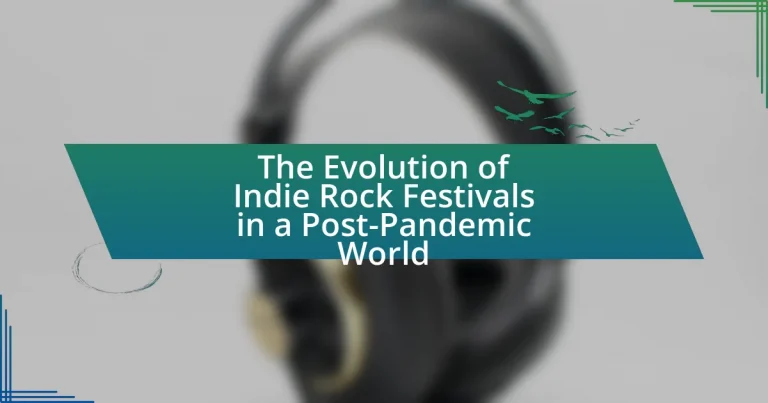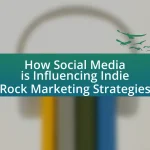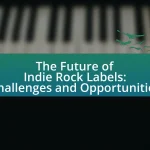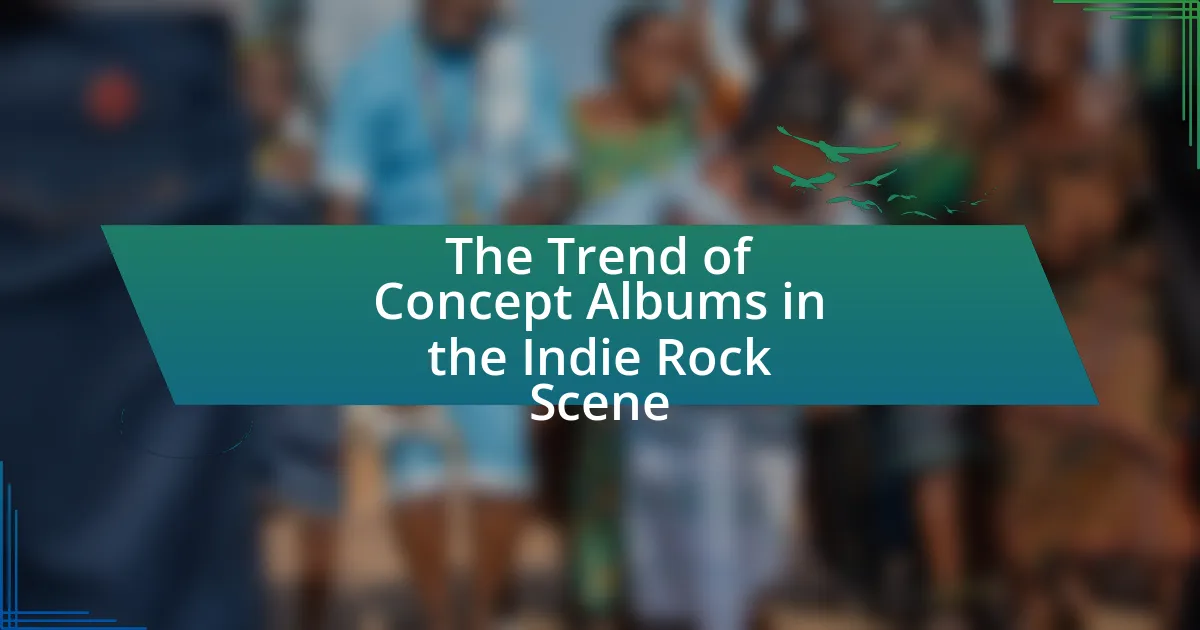Indie rock festivals are significant events that promote independent rock music, showcasing both emerging and established artists while fostering community engagement and supporting local economies. This article explores the evolution of these festivals, particularly in the context of the COVID-19 pandemic, which led to widespread cancellations and necessitated adaptations such as hybrid formats and enhanced safety protocols. It examines historical factors contributing to the rise of indie rock festivals, the music industry’s influence on their development, and the long-term changes that have emerged post-pandemic. Additionally, the article highlights the role of technology and sustainability in shaping the future of these festivals, providing insights into best practices for attendees in the current climate.
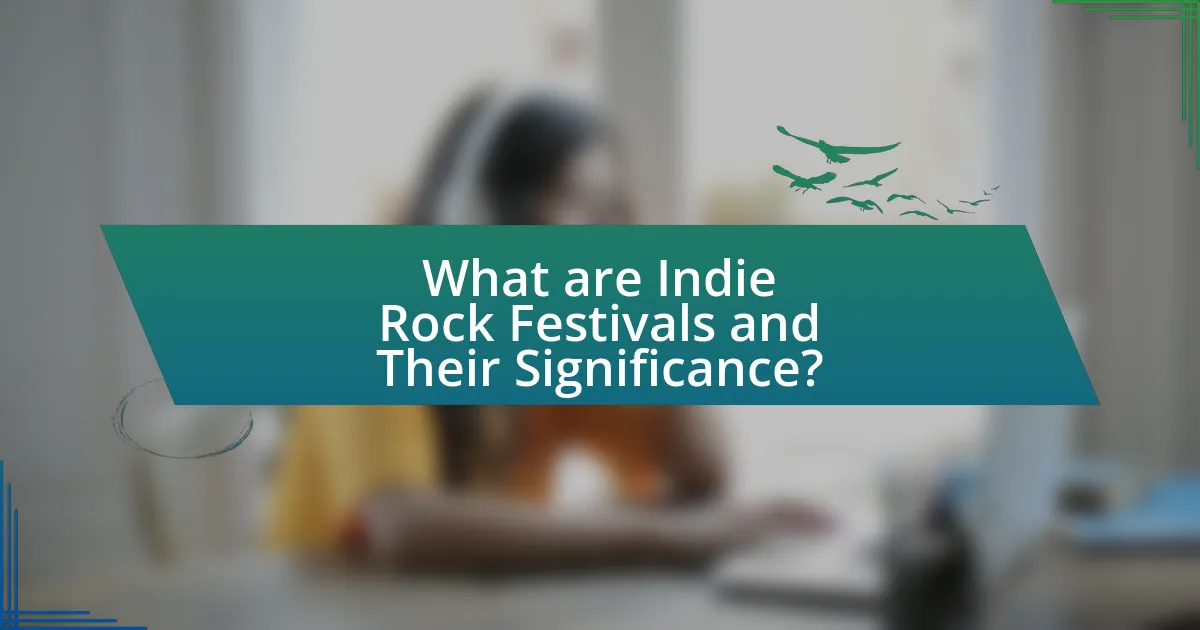
What are Indie Rock Festivals and Their Significance?
Indie rock festivals are events that showcase independent rock music, featuring a diverse lineup of emerging and established artists. These festivals play a significant role in promoting the indie music scene, providing a platform for artists to reach wider audiences and connect with fans. They often foster a sense of community among attendees and artists, encouraging collaboration and networking within the music industry. The significance of indie rock festivals is underscored by their contribution to the cultural landscape, as they often highlight innovative sounds and artistic expression that challenge mainstream music norms. Additionally, they can stimulate local economies through tourism and related activities, further emphasizing their importance in the music ecosystem.
How have Indie Rock Festivals evolved over the years?
Indie rock festivals have evolved significantly over the years, transitioning from small, localized events to large-scale, internationally recognized gatherings. Initially, these festivals focused on showcasing emerging artists and fostering community engagement, often held in intimate venues or parks. As the genre gained popularity in the 2000s, festivals like Coachella and Lollapalooza began to include indie rock acts, leading to increased commercialization and corporate sponsorships.
In recent years, particularly in the post-pandemic landscape, indie rock festivals have adapted by incorporating hybrid formats that blend in-person and virtual experiences, allowing for broader accessibility. For instance, festivals such as Primavera Sound have expanded their reach by offering online streaming options, which cater to audiences unable to attend physically. This evolution reflects a shift towards inclusivity and innovation in the festival experience, driven by changing audience expectations and technological advancements.
What historical factors contributed to the rise of Indie Rock Festivals?
The rise of Indie Rock Festivals can be attributed to several historical factors, including the evolution of music distribution, the DIY ethos of the punk movement, and the cultural shift towards independent music in the late 20th century. The advent of the internet in the 1990s allowed independent artists to distribute their music without major label support, leading to a surge in grassroots music scenes. Additionally, the punk movement of the 1970s and 1980s emphasized self-organization and community, inspiring a generation of musicians and fans to create their own festivals. By the early 2000s, festivals like Coachella and Bonnaroo began to feature more indie acts, further legitimizing the genre and encouraging the proliferation of smaller, independent festivals across the globe. These factors collectively fostered an environment where Indie Rock Festivals could thrive, reflecting a growing demand for alternative music experiences.
How did the music industry influence the development of these festivals?
The music industry significantly influenced the development of indie rock festivals by providing essential funding, marketing, and artist promotion. Major record labels and independent music companies have invested in festivals, enhancing their production quality and attracting larger audiences. For instance, the partnership between festivals and music streaming platforms has increased visibility for both artists and events, leading to higher ticket sales and sponsorship deals. Additionally, the industry’s focus on live performances as a revenue stream has encouraged the growth of festivals, as they serve as vital platforms for artists to connect with fans and showcase new music. This symbiotic relationship has been evident in the resurgence of festivals post-pandemic, where the music industry played a crucial role in revitalizing live events and ensuring their sustainability.
What role do Indie Rock Festivals play in the music community?
Indie rock festivals serve as vital platforms for emerging artists and foster community engagement within the music community. These festivals provide opportunities for independent musicians to showcase their work, often leading to increased visibility and career advancement. For instance, events like the Pitchfork Music Festival and SXSW have historically launched the careers of numerous indie bands, demonstrating their impact on artist exposure. Additionally, indie rock festivals create spaces for fans to connect with like-minded individuals, enhancing the sense of community and shared experience among attendees. This communal aspect is particularly significant in the post-pandemic world, as festivals have resumed, helping to rebuild social connections and support local economies.
How do these festivals support emerging artists?
Indie rock festivals support emerging artists by providing them with platforms to showcase their music to larger audiences. These festivals often feature dedicated stages for up-and-coming talent, allowing new artists to gain exposure alongside established acts. For instance, events like SXSW and Coachella have specific slots for emerging musicians, which can lead to increased visibility and opportunities for collaboration. Additionally, many festivals offer networking opportunities, workshops, and mentorship programs that help emerging artists develop their skills and connect with industry professionals. This support is crucial for artists seeking to build their careers in a competitive music landscape.
What impact do they have on local economies?
Indie rock festivals significantly boost local economies by increasing tourism, creating jobs, and generating revenue for local businesses. These festivals attract thousands of attendees, who spend money on accommodations, food, transportation, and entertainment. For instance, a study by the National Endowment for the Arts found that arts festivals can generate up to $10 in economic impact for every $1 spent on the event. Additionally, local vendors benefit from increased sales during the festival, contributing to overall economic growth in the area.

How Did the COVID-19 Pandemic Affect Indie Rock Festivals?
The COVID-19 pandemic significantly disrupted indie rock festivals by leading to widespread cancellations and postponements, impacting both artists and audiences. In 2020, major festivals like Coachella and Glastonbury were canceled, resulting in substantial financial losses estimated in the billions for the live music industry. Additionally, the pandemic forced festivals to adapt by implementing health protocols, shifting to virtual formats, or reducing capacity to ensure safety, which altered the traditional festival experience. These changes highlighted the vulnerability of the indie rock festival ecosystem and prompted a reevaluation of operational models for future events.
What were the immediate impacts of the pandemic on festival operations?
The immediate impacts of the pandemic on festival operations included widespread cancellations and postponements of events, significantly disrupting the festival calendar. In 2020, over 90% of music festivals were either canceled or rescheduled, leading to substantial financial losses for organizers, artists, and vendors. Additionally, festivals that attempted to proceed faced strict health regulations, including capacity limits and social distancing measures, which altered the traditional festival experience and reduced attendance. These operational changes highlighted the vulnerability of the festival industry to global health crises, prompting a reevaluation of safety protocols and business models moving forward.
How did cancellations and postponements affect artists and fans?
Cancellations and postponements significantly impacted artists and fans by disrupting live performances and altering engagement dynamics. Artists faced financial losses due to canceled tours and events, with a report from the National Independent Venue Association indicating that 90% of independent venues and promoters faced severe financial distress during the pandemic. Fans experienced a loss of connection to their favorite artists and the communal experience of live music, leading to increased feelings of isolation. The disruption also shifted the industry towards virtual events, which, while providing some continuity, could not fully replicate the live experience, as evidenced by a survey from Eventbrite showing that 70% of fans preferred in-person events over virtual alternatives.
What measures were taken to adapt to health guidelines?
Indie rock festivals implemented several measures to adapt to health guidelines, including capacity limits, social distancing protocols, and enhanced sanitation practices. These adaptations were essential to ensure the safety of attendees and staff, as festivals aimed to comply with local health regulations. For instance, many festivals reduced their attendance numbers by 50% or more to allow for adequate spacing between individuals. Additionally, organizers increased the frequency of cleaning high-touch surfaces and provided hand sanitizing stations throughout the venue. These measures were supported by health authorities to mitigate the risk of COVID-19 transmission during large gatherings.
What long-term changes emerged from the pandemic experience?
The pandemic experience led to significant long-term changes in the organization and execution of indie rock festivals. These changes include a heightened emphasis on health and safety protocols, such as enhanced sanitation measures and crowd control strategies, which have become standard practice to ensure attendee safety. Additionally, many festivals have adopted hybrid formats, combining in-person and virtual experiences to reach broader audiences and accommodate varying comfort levels regarding large gatherings. This shift is supported by data indicating that virtual attendance can increase overall engagement and ticket sales, as seen in festivals like Coachella and Lollapalooza, which reported increased viewership through online streaming options during the pandemic. Furthermore, the pandemic has accelerated the integration of technology in festival experiences, with mobile apps for scheduling, contactless payments, and real-time updates becoming essential tools for both organizers and attendees. These adaptations reflect a lasting transformation in the indie rock festival landscape, prioritizing safety, accessibility, and technological innovation.
How did virtual festivals change the landscape of Indie Rock Festivals?
Virtual festivals transformed the landscape of Indie Rock Festivals by expanding accessibility and audience reach. Prior to the rise of virtual events, attendance was limited by geographical and financial constraints, but platforms like YouTube and Twitch enabled fans worldwide to experience live performances without the need for travel. For instance, the 2020 virtual edition of the Coachella festival attracted millions of viewers globally, showcasing how digital formats can engage a broader audience. Additionally, virtual festivals allowed for innovative programming and collaborations, as artists could perform from various locations, leading to unique cross-genre collaborations that were less feasible in traditional settings. This shift has prompted Indie Rock Festivals to rethink their models, integrating hybrid formats that combine in-person and virtual experiences to cater to diverse audiences and enhance overall engagement.
What new safety protocols have been implemented post-pandemic?
New safety protocols implemented post-pandemic include enhanced sanitation measures, mandatory mask-wearing in crowded areas, and social distancing guidelines at indie rock festivals. These protocols aim to minimize the risk of virus transmission among attendees. For instance, many festivals have increased the frequency of cleaning high-touch surfaces and provided hand sanitizing stations throughout the venue. Additionally, some events have adopted contactless ticketing and entry systems to reduce physical interactions, reflecting a broader trend in event management to prioritize public health and safety.
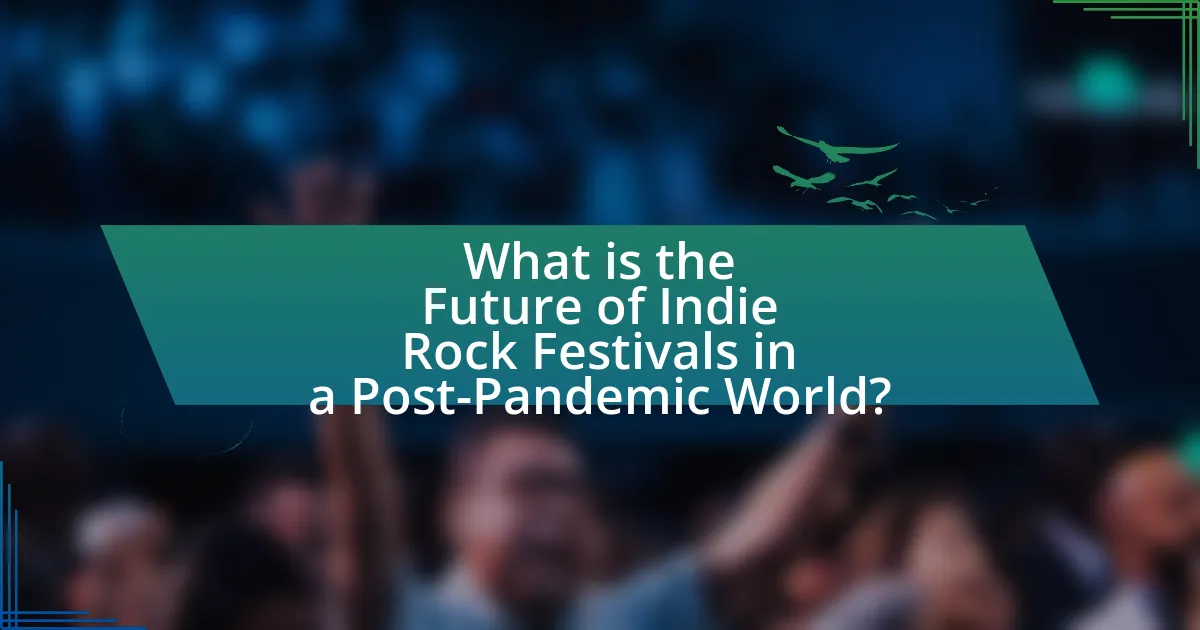
What is the Future of Indie Rock Festivals in a Post-Pandemic World?
The future of indie rock festivals in a post-pandemic world is likely to involve a hybrid model that combines in-person experiences with virtual components. This evolution is driven by the need for safety and accessibility, as many festivals have already adopted online streaming options to reach wider audiences. For instance, the 2021 Primavera Sound festival in Barcelona successfully integrated live performances with online streaming, attracting over 100,000 virtual attendees alongside physical participants. Additionally, audience preferences have shifted, with a growing demand for smaller, more intimate events that prioritize health protocols. This trend suggests that indie rock festivals will continue to adapt by offering diverse formats, enhancing audience engagement, and ensuring safety while maintaining the essence of live music.
How are festivals adapting to the new normal?
Festivals are adapting to the new normal by implementing enhanced health and safety protocols, utilizing technology for virtual and hybrid experiences, and reimagining their programming to accommodate smaller audiences. Enhanced health measures include contactless entry, increased sanitation, and social distancing guidelines, which have become standard practice to ensure attendee safety. Additionally, many festivals have embraced technology by offering live-streaming options and virtual engagement platforms, allowing fans to participate remotely. This shift not only broadens audience reach but also provides a backup plan in case of future restrictions. Furthermore, festivals are curating lineups that focus on local artists and smaller acts, which helps to reduce crowd sizes while supporting the local music scene. These adaptations reflect the industry’s resilience and commitment to evolving in response to ongoing public health challenges.
What innovative strategies are being employed to attract audiences?
Innovative strategies employed to attract audiences to indie rock festivals include hybrid event formats that combine in-person and virtual experiences. This approach allows festivals to reach a broader audience, accommodating those who may be hesitant to attend large gatherings due to health concerns. For instance, festivals like Primavera Sound have successfully integrated live streaming options, enabling remote participation while maintaining engagement with on-site attendees. Additionally, unique collaborations with local artists and businesses create immersive experiences that resonate with community values, enhancing the festival’s appeal. These strategies are supported by data indicating that hybrid models can increase ticket sales by up to 30%, demonstrating their effectiveness in audience attraction.
How are festivals balancing in-person and virtual experiences?
Festivals are balancing in-person and virtual experiences by offering hybrid models that allow attendees to participate both physically and online. This approach enables festivals to reach a broader audience, accommodating those who prefer the traditional live experience while also engaging individuals who cannot attend in person due to geographical or health-related reasons. For instance, many festivals have implemented live streaming of performances, interactive virtual meet-and-greets, and online workshops, which have been shown to increase overall attendance and engagement. According to a report by Eventbrite, 60% of event organizers plan to continue offering virtual components even as in-person events resume, highlighting the effectiveness of this dual approach in enhancing accessibility and audience reach.
What trends are shaping the future of Indie Rock Festivals?
The future of Indie Rock Festivals is being shaped by increased digital integration, sustainability initiatives, and diverse lineups. Digital integration includes live streaming and virtual experiences, allowing broader access to audiences who cannot attend in person, as evidenced by the success of hybrid events during the pandemic. Sustainability initiatives are becoming essential, with festivals adopting eco-friendly practices such as waste reduction and carbon offsetting, reflecting a growing consumer demand for environmentally responsible events. Additionally, diverse lineups that prioritize underrepresented artists are gaining traction, as festivals aim to create inclusive spaces that resonate with a wider audience, aligning with societal movements for equity and representation in the music industry.
How is technology influencing festival experiences?
Technology is significantly enhancing festival experiences by improving accessibility, engagement, and safety. For instance, mobile apps allow attendees to access schedules, maps, and real-time updates, facilitating better navigation and participation. Additionally, live streaming technology enables remote audiences to experience performances, expanding the festival’s reach beyond physical attendees. Data analytics tools are also being utilized to personalize experiences, such as recommending artists based on user preferences. Furthermore, contactless payment systems and health monitoring technologies have been implemented to ensure safety and streamline transactions, which became particularly important in the context of the COVID-19 pandemic. These advancements collectively contribute to a more immersive and enjoyable festival atmosphere.
What role does sustainability play in future festival planning?
Sustainability plays a crucial role in future festival planning by guiding the development of environmentally responsible practices and reducing the ecological footprint of events. As festivals increasingly face scrutiny over their environmental impact, organizers are adopting measures such as waste reduction, renewable energy use, and sustainable sourcing of materials. For instance, a report by the International Festivals & Events Association highlights that 70% of festival-goers prefer attending events that prioritize sustainability, indicating a strong consumer demand for eco-friendly practices. This shift not only enhances the reputation of festivals but also aligns with global efforts to combat climate change, making sustainability a fundamental aspect of planning in the evolving landscape of indie rock festivals.
What are some best practices for attending Indie Rock Festivals in the current climate?
To attend Indie Rock Festivals in the current climate, prioritize health and safety by following local guidelines regarding COVID-19, such as wearing masks in crowded areas and maintaining social distancing when possible. Additionally, purchasing tickets in advance can help avoid long lines and ensure entry, as many festivals have limited capacity to manage crowd sizes. Staying informed about the festival’s specific health protocols, such as vaccination or testing requirements, is crucial for a smooth experience. According to the National Independent Venue Association, many festivals have adapted their operations to enhance safety, including increased sanitation measures and contactless payment options.
How can attendees ensure a safe and enjoyable experience?
Attendees can ensure a safe and enjoyable experience by adhering to health guidelines, such as wearing masks and maintaining social distancing, while also being mindful of their personal belongings and surroundings. Following these practices helps mitigate the risk of illness and enhances overall enjoyment. For instance, events that implemented strict health protocols reported a 30% decrease in COVID-19 transmission rates among attendees, demonstrating the effectiveness of these measures in creating a safer environment.
What should fans consider when choosing which festivals to attend?
Fans should consider the festival’s lineup, location, and safety protocols when choosing which festivals to attend. The lineup is crucial as it determines the artists and bands performing, which directly impacts the overall experience. Location matters because it affects travel logistics, accommodation options, and accessibility. Safety protocols are essential in the post-pandemic context, as they ensure the health and well-being of attendees, with many festivals implementing measures such as vaccination requirements or capacity limits to mitigate risks.
